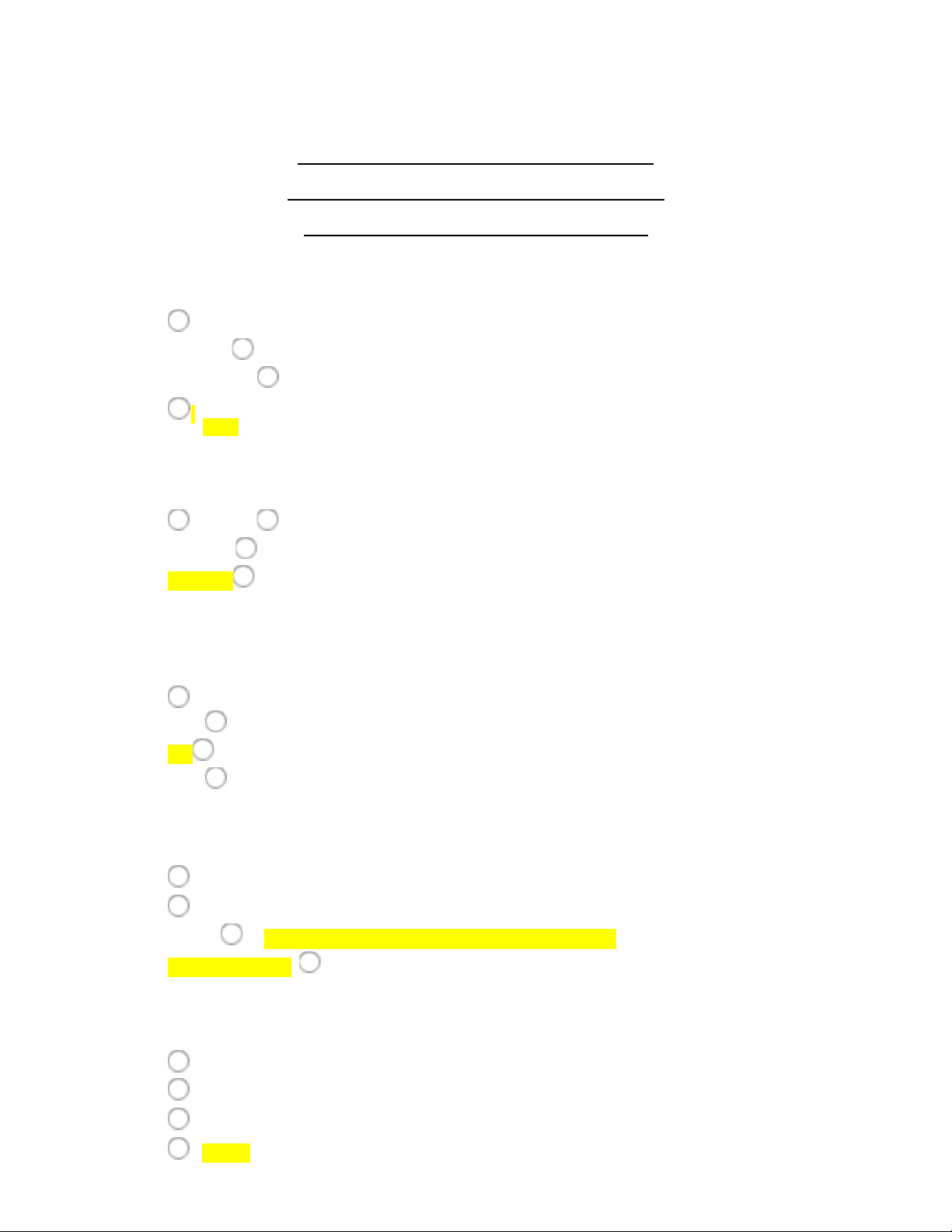
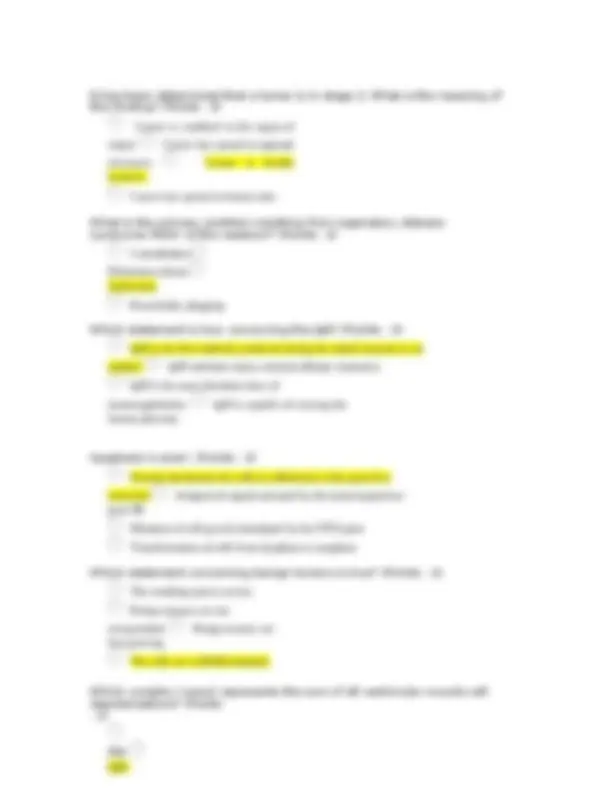

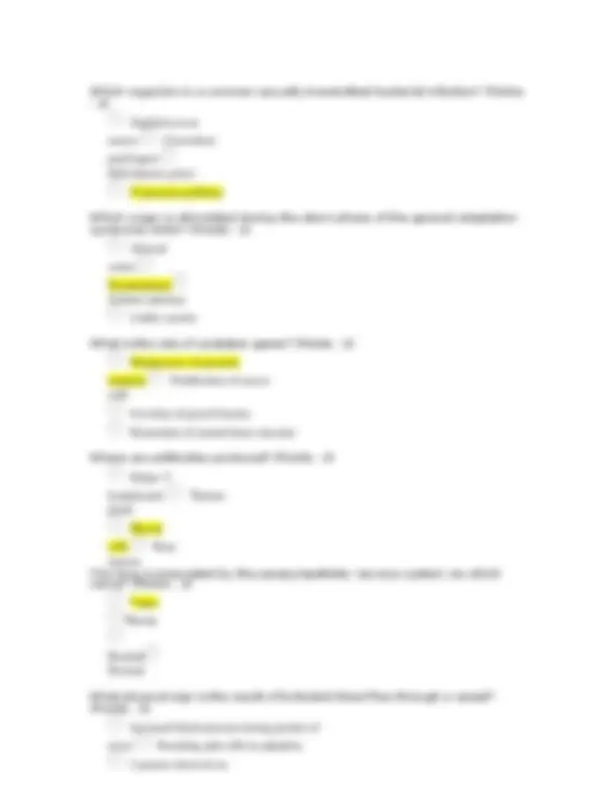

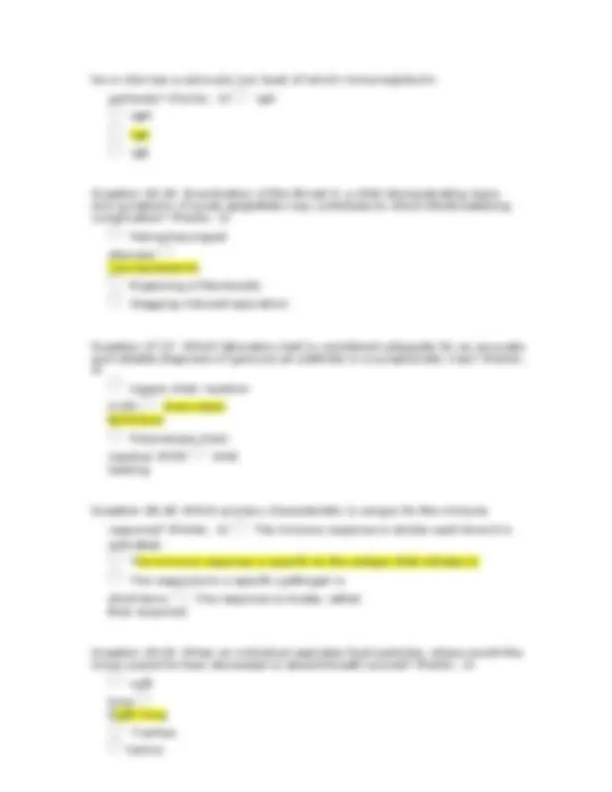
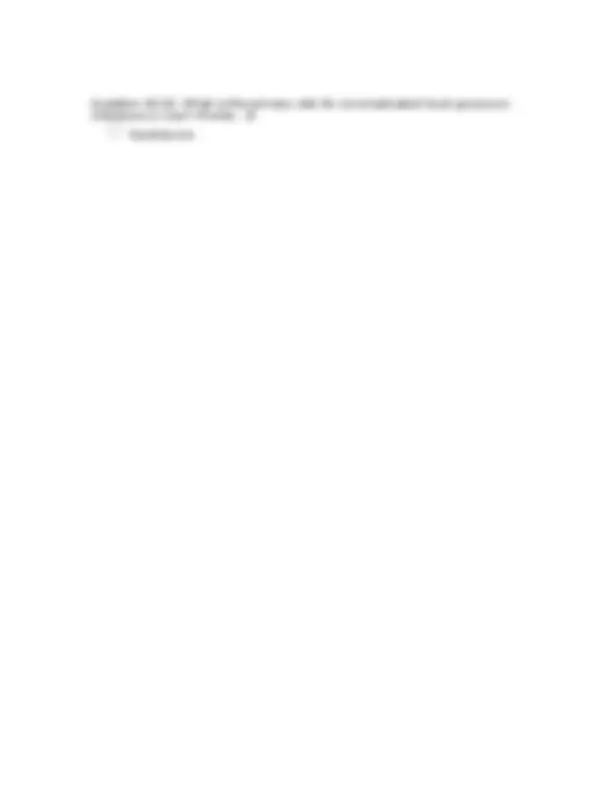
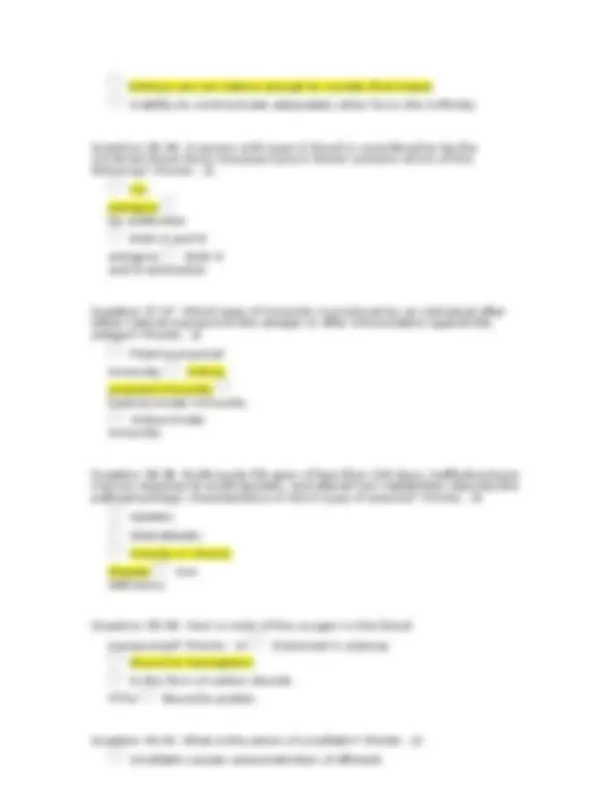
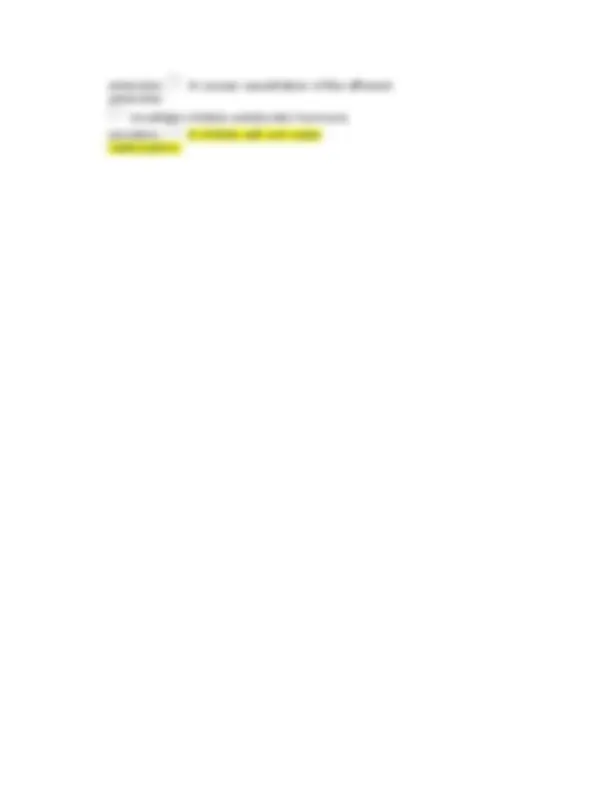
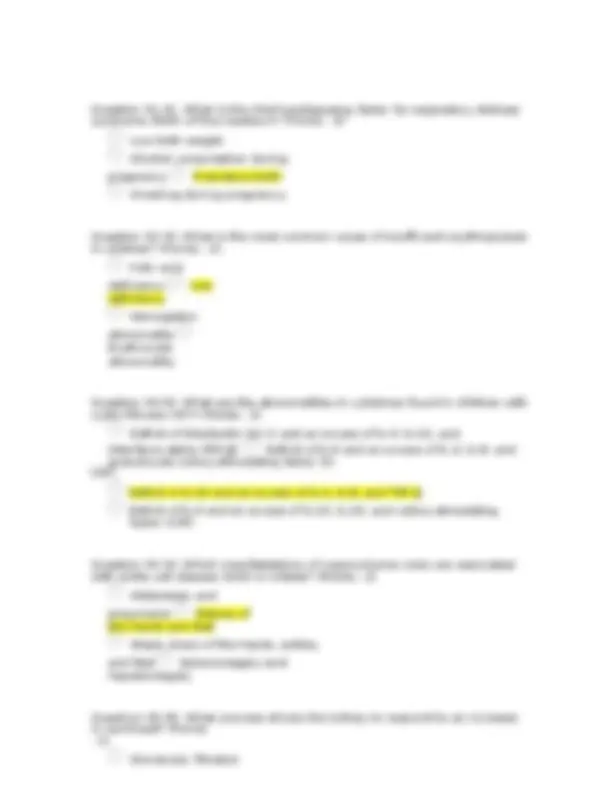

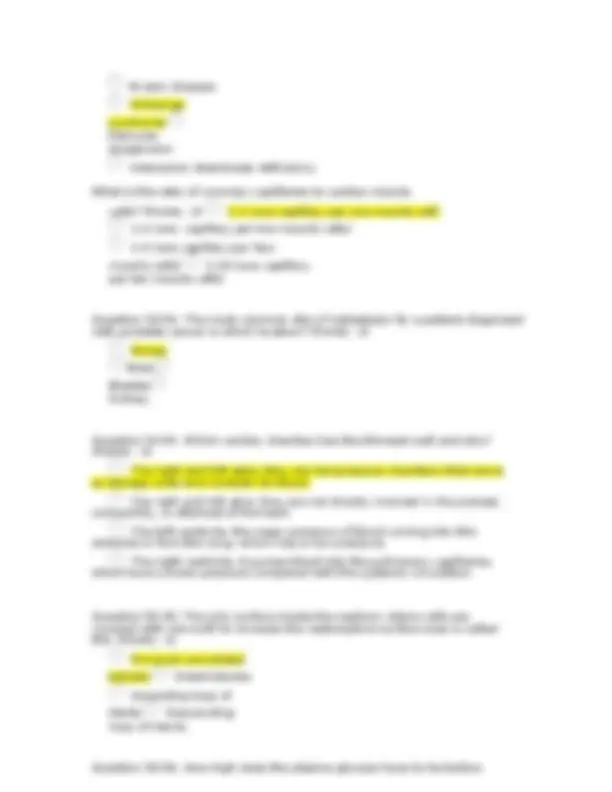

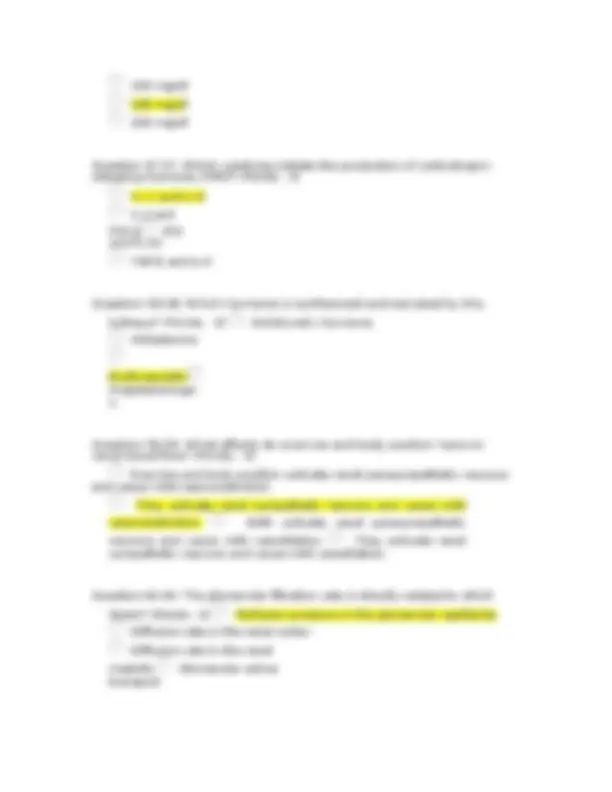


Study with the several resources on Docsity

Earn points by helping other students or get them with a premium plan


Prepare for your exams
Study with the several resources on Docsity

Earn points to download
Earn points by helping other students or get them with a premium plan
Community
Ask the community for help and clear up your study doubts
Discover the best universities in your country according to Docsity users
Free resources
Download our free guides on studying techniques, anxiety management strategies, and thesis advice from Docsity tutors
NUR 507 Week 4 Midterm 58/60 = 96.7%Latest Update 2023 Guaranteed Success.
Typology: Exams
1 / 21

This page cannot be seen from the preview
Don't miss anything!














The coronary ostia are located in the: (Points : 2)
Where in the respiratory tract do the majority of foreign objects aspirated by children finally lodge? (Points : 2)
Which type of antibody is involved in type I hypersensitivity reaction? (Points :
Hypersensitivity is best defined as a(an): (Points : 2)
What is the final stage of the infectious process? (Points : 2)
The function of the foramen ovale in a fetus allows what to occur? (Points : 2)
Which organism is a common sexually transmitted bacterial infection? (Points : 2)
Which organ is stimulated during the alarm phase of the general adaptation syndrome (GAS)? (Points : 2)
What is the role of caretaker genes? (Points : 2)
Where are antibodies produced? (Points : 2)
The lung is innervated by the parasympathetic nervous system via which nerve? (Points : 2)
What physical sign is the result of turbulent blood flow through a vessel? (Points : 2)
What is the fundamental physiologic manifestation of anemia? (Points : 2)
Which term is used to describe a muscle cell showing a reduced ability to form new muscle while appearing highly disorganized? (Points : 2)
Which of the following is classified as a megaloblastic anemia? (Points : 2)
How is most carbon dioxide (CO 2 ) in the blood transported? (Points : 2) Attached to oxygen In the form of bicarbonate Combined with albumin Dissolved in the plasma Question 24.24. Which immunoglobulin (Ig) is present in childhood asthma? (Points : 2) IgM IgG IgE IgA
Question 25.25. An individual is more susceptible to infections of mucous membranes when
Question 30.30. What is the primary site for uncomplicated local gonococci infections in men? (Points : 2) Epididymis
Lymph nodes Urethra Prostate Question 31.31. Deficiencies in which element can produce depression of both B- and T-cell function? (Points : 2) Iron Zinc Iodine Magnesium Question 32.32. An infant has a loud, harsh, holosystolic murmur and systolic thrill that can be detected at the left lower sternal border that radiates to the neck. These clinical findings are consistent with which congenital heart defect? (Points : 2) Atrial septal defect (ASD) Ventricular septal defect (VSD) Patent ductus arteriosus (PDA) Atrioventricular canal (AVC) defect Question 33.33. Which compensatory mechanism is spontaneously used by children diagnosed with tetralogy of Fallot to relieve hypoxic spells? (Points : 2) Lying on their left side Performing the Valsalva maneuver Squatting Hyperventilating Question 34.34. In a normal, nonmutant state, an oncogene is referred to as a: (Points : 2) Basal cell Target cell Caretaker gene Proto- oncogene Question 35.35. Infants are most susceptible to significant losses in total body water because of an infant’s: (Points : 2)
Kidneys are not mature enough to counter fluid losses Inability to communicate adequately when he or she is thirsty Question 36.36. A person with type O blood is considered to be the universal blood donor because type O blood contains which of the following? (Points : 2) No antigens No antibodies Both A and B antigens Both A and B antibodies Question 37.37. Which type of immunity is produced by an individual after either natural exposure to the antigen or after immunization against the antigen? (Points : 2) Passive-acquired immunity Active- acquired immunity Passive-innate immunity Active-innate immunity Question 38.38. Erythrocyte life span of less than 120 days, ineffective bone marrow response to erythropoietin, and altered iron metabolism describe the pathophysiologic characteristics of which type of anemia? (Points : 2) Aplastic Sideroblastic Anemia of chronic disease Iron deficiency Question 39.39. How is most of the oxygen in the blood transported? (Points : 2) Dissolved in plasma Bound to hemoglobin In the form of carbon dioxide (CO 2 ) (^) Bound to protein Question 40.40. What is the action of urodilatin? (Points : 2) Urodilatin causes vasoconstriction of afferent
arterioles. It causes vasodilation of the efferent arterioles. Urodilatin inhibits antidiuretic hormone secretion. It inhibits salt and water reabsorption.
Secretion of 1,25- dihydroxyvitamin D 3 Increased heart rate Compensatory hypertrophy
Question 46.46. What is the direct action of atrial natriuretic hormone? (Points : 2) Sodium retention Sodium excretion Water retention Water excretion Question 47.47. Which cells have phagocytic properties similar to monocytes and contract like smooth muscles cells, thereby influencing the glomerular filtration rate? (Points : 2) Principle cells Podocin cells Mesangial cells Intercalated cells Question 48.48. Research supports the premise that exercise has a probable impact on reducing the risk of which cancer? (Points : 2) Liver Endometrial Stomach Colon Question 49.49. What effect do natriuretic peptides have during heart failure when the heart dilates? (Points : 2) Stimulates antidiuretic hormones. Inhibits antidiuretic hormones. Stimulates renin and aldosterone. Inhibits renin and aldosterone. Question 50.50. Which T-lymphocyte phenotype is the key determinant of childhood asthma? (Points : 2) Cluster of differentiation (CD) 4 T-helper Th 1 lymphocytes CD4 T-helper Th 2 lymphocytes CD8 cytotoxic T lymphocytes Memory T lymphocytes
Bruton disease DiGeorge syndrome Reticular dysgenesis Adenosine deaminase deficiency What is the ratio of coronary capillaries to cardiac muscle cells? (Points : 2) 1:1 (one capillary per one muscle cell) 1:2 (one capillary per two muscle cells) 1:4 (one capillary per four muscle cells) 1:10 (one capillary per ten muscle cells) Question 53.53. The most common site of metastasis for a patient diagnosed with prostate cancer is which location? (Points : 2) Bones Brain Bladder Kidney Question 54.54. Which cardiac chamber has the thinnest wall and why? (Points : 2) The right and left atria; they are low-pressure chambers that serve as storage units and conduits for blood. The right and left atria; they are not directly involved in the preload, contractility, or afterload of the heart. The left ventricle; the mean pressure of blood coming into this ventricle is from the lung, which has a low pressure. The right ventricle; it pumps blood into the pulmonary capillaries, which have a lower pressure compared with the systemic circulation. Question 55.55. The only surface inside the nephron where cells are covered with microvilli to increase the reabsorptive surface area is called the: (Points : 2) Proximal convoluted tubules Distal tubules Ascending loop of Henle Descending loop of Henle Question 56.56. How high does the plasma glucose have to be before
the threshold for glucose is achieved? (Points : 2) 126 mg/dl